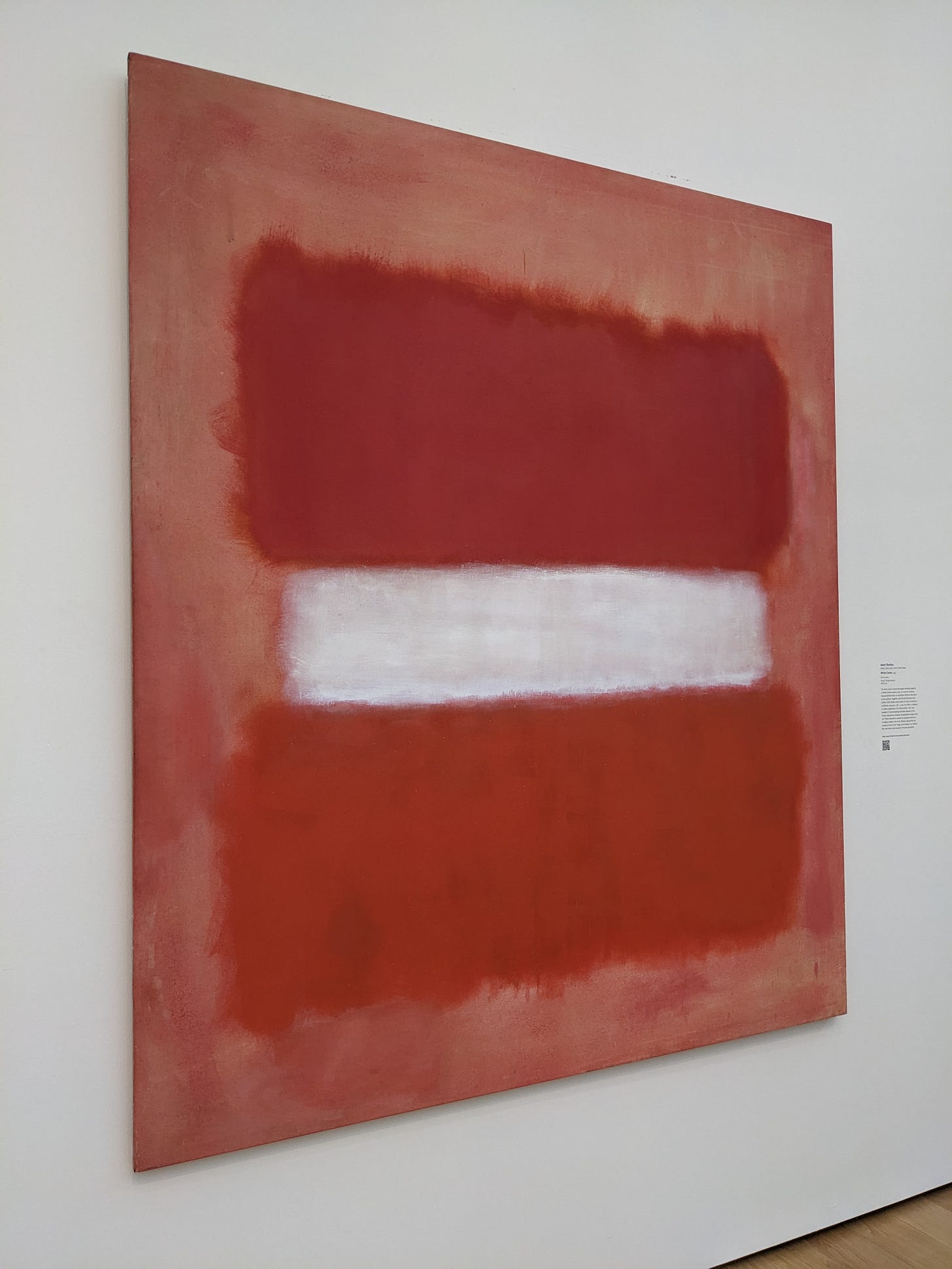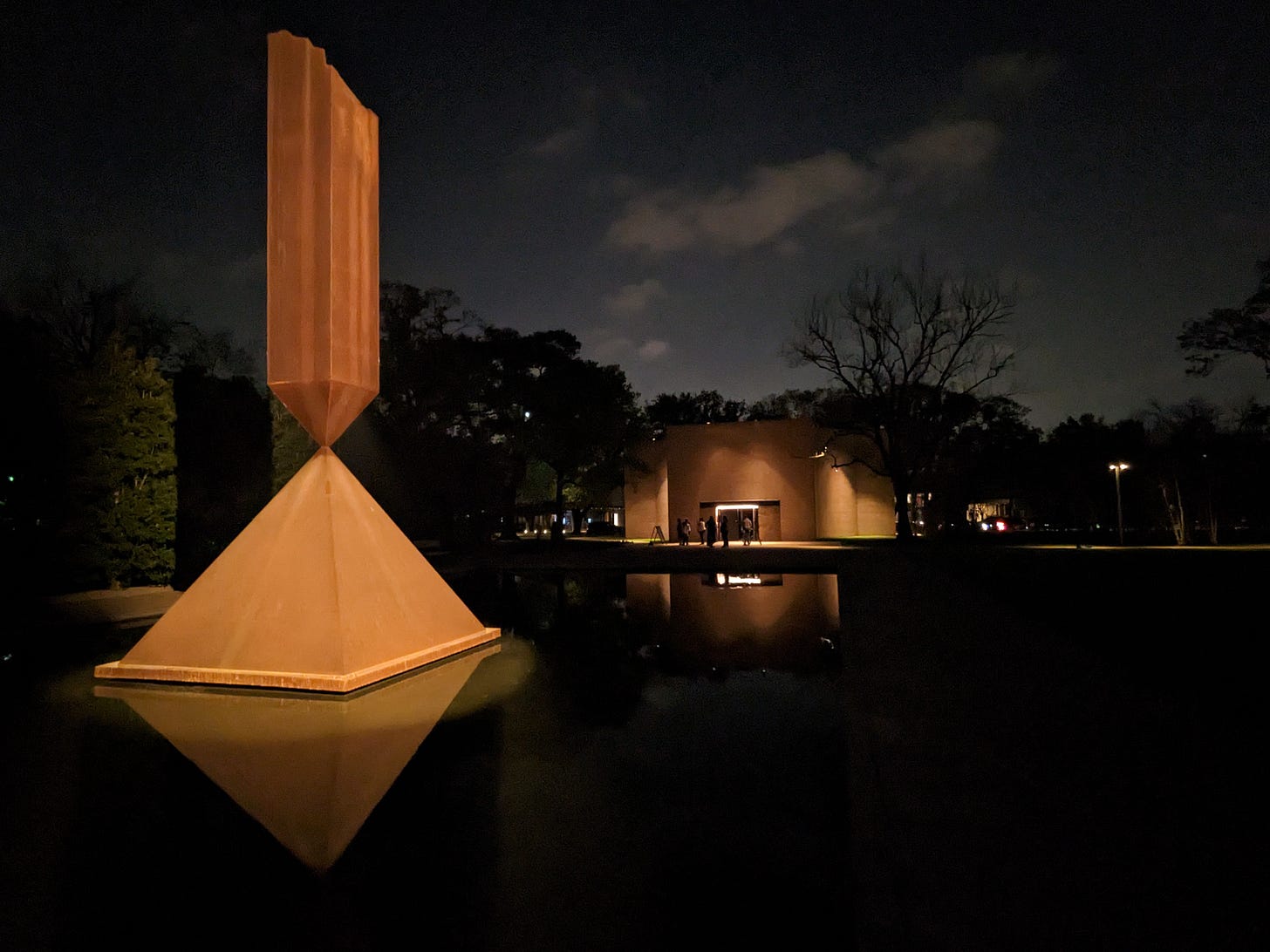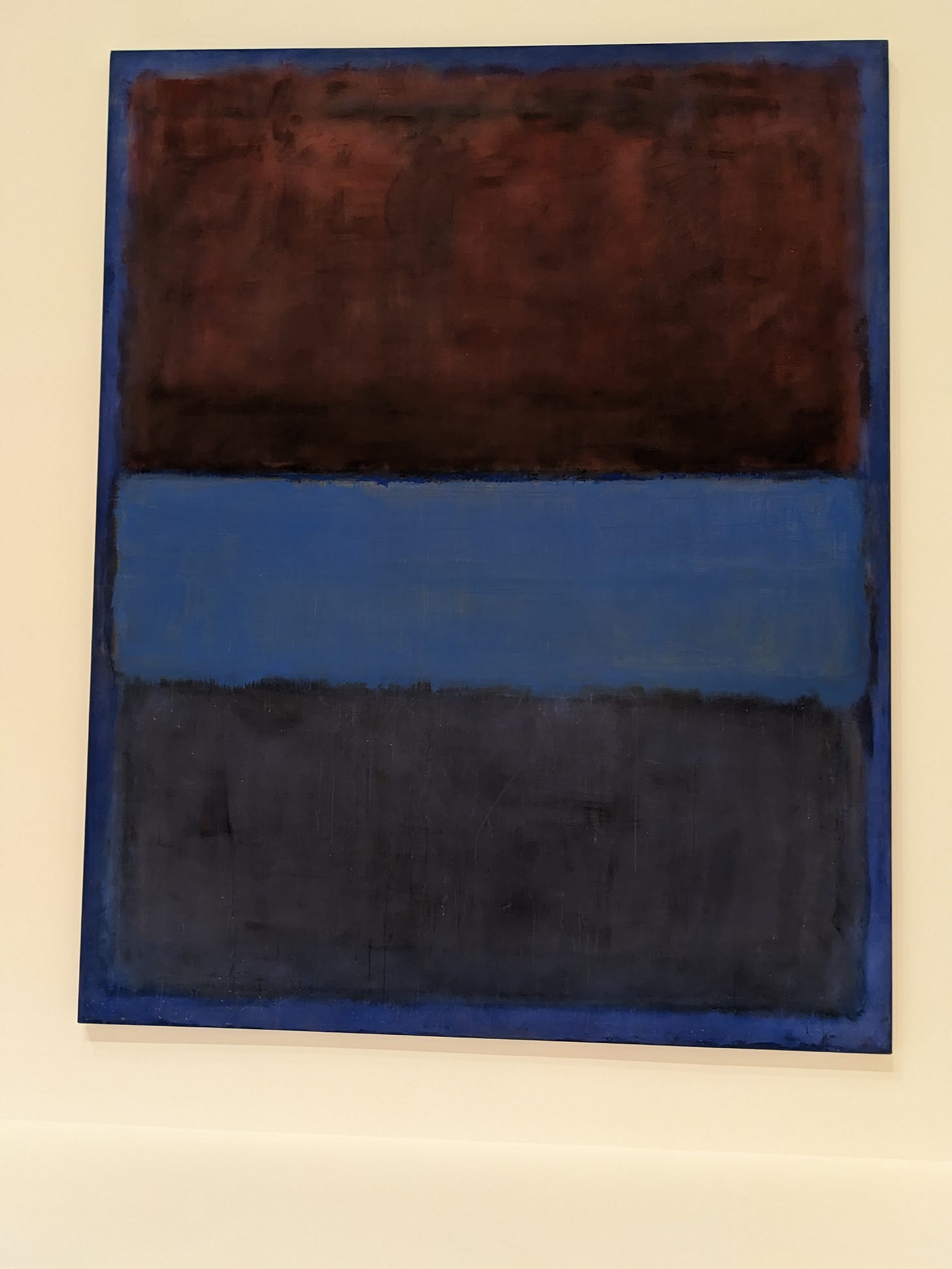Rothko, Finding Meaning in Modern Art, & the Value of Seeing Transcendent Work IRL
Some things can only be understood in person
A tweet about the 2021 sale of Russian-born American painter Mark Rothko's "No.7" (1951) selling for $82.5M with the caption, "Explain what this painting means and why it is good," recently went viral over on Twitter/X, kicking off a discussion about modern art, particularly Rothko's work. There have been plenty of the usual responses to modern art: a kid could do this, this is meaningless, I could paint something better, the obscene amount of money could go to something better (on this one they’re not wrong, and Rothko himself would probably feel the same!) But there have also been some wonderful conversations too, with people of varying levels of knowledge of art, all talking about Rothko’s work and what it meant to them to experience it firsthand.
The one resource we can never renew is our time, and that makes it the most precious. Choosing to invest our time in something like Rothko’s work is deliberate and asks more of us than so many of our passive, screen-based hobbies. Don’t get me wrong, I love those too and I hate the disturbing levels of wealth in the art world, but there’s something to be said for a phenomenon that simply cannot be replicated or abbreviated, one where we get out what we put into it. The only thing naysayers and cynics achieve is cutting themselves off from an opportunity to feel something new and different, something remarkable and astounding.
I’ve been lucky enough to see Rothko’s work in person many times, and while I would argue that most art is better in person, his in particular requires an offline encounter in order to be fully appreciated. At a very surface level, his paintings are much larger than you might expect from seeing them through a phone screen, averaging 60.4” x 52.6.” Rothko intended for his color field paintings to overwhelm the viewer, in a very literal sense. They’re so large because he wanted them to evoke an emotional experience in people once they have nothing but these large swaths of color filling their vision in every direction.
While some people might find abstract work intimidating, you don’t need to be an expert by any means to appreciate or even understand it, and the many everyday people sharing their Rothko stories proves that. What does make all the difference, though, is seeing his work in person, and the amount of time and attention you’re willing to put in. It can feel awkward to sit or stand in front of a painting for many long minutes if it’s not something you’re used to, especially if you’re not sure what you’re meant to be seeing or understanding. Some refer to this practice as “close looking,” but I don’t like to be quite so formal as that.
At a time when it feels like the world is at our fingertips, all the answers are in our phones, and everything is lightning fast, Rothko's work is the opposite, the anti-tl;dr.
One of my favorite things about Rothkos is that they reward viewers for investing their time and attention, deepening the experience as you're better able to perceive true variations in color, and perhaps variations in your own emotions while the colors wash over you. At a time when it feels like the world is at our fingertips, all the answers are in our phones, and everything is lightning fast, Rothko's work is the opposite, the anti-tl;dr. It is best--really, only--experienced in person, slowly, and has not one answer but many--maybe even infinite. The joy and wonder of abstract work, for me, is that you are released from the pressure of one correct answer; whatever you find in the work is right for you.
This exponential understanding is especially true of his pieces at the Rothko Chapel in Houston, Texas, which Rothko completed in 1967. (Sadly he died in 1970, before the Chapel itself was built, opening in 1971.) The murals at the Chapel, which had to be lowered into the building through the skylight due to their size (the smallest is more than 15’ x 8’), appear to be uniform in gray tone at first glance. They certainly look that way through a phone screen, though you're not allowed to use one or take photos inside, further supporting the idea that the Rothko Chapel is a place to be present in the here and now. As your eyes acclimate to the natural light and you give over to the phenomenon of being overwhelmed by the massive color fields, a rich depth of color emerges - chalky whiteness, more blue than I would have ever guessed, and the one that’s actually so pink.
The thing about these 14 painted panels is that they teach you how to understand them, read them, look at them. The longer you look at them, the better you understand what you're seeing, as your eye adjusts to what at first seemed to be monotonal dark gray. The paintings are training you how to understand them. While there is a physical aspect to parsing what you’re literally looking at, there’s a mental and emotional component as well. If you’re willing to give yourself over to being subsumed by the paintings, putting in the time to let your eyes adjust and better discern color, pattern, and texture can open you up to a sort of meditative state and something of an internal journey as your mind pursues its own exploration and interpretation.
Once they reveal themselves to you, as with any of Rothko's transcendent work, you can never go back. Even if a cloud shifts to block the sun coming in between the slats in the cupola and you can't see everything for a moment, you can't go back to when you didn't know what was lurking in the depths of color, back to when you weren't moved. To me, that's what Rothko's work means, and that's "why it is good," whatever "good" means.
When I went to the Rothko Chapel last March, by unusual happenstance I visited at night first for an International Women’s Day service, and it was completely different to return again during daylight. The nondenominational chapel is built around the idea of natural light, so it changes everything in the space, to the point where I was disappointed when it went away. Maybe others don’t feel this way, but with my poor eyesight and chronic migraine with aura, losing the light meant losing much of the differentiation, and my eyes ached more than usual as I tried to see it anyway.
I spent more than an hour inside, and during that time I saw colors and shapes emerge and change. I had a variety of emotions. One way to approach abstract modern art like Rothko’s is to look for metaphorical shapes in the clouds, to allow your mind to see what it finds and to make some kind of meaning out of that, like the brain coral, map of city streets, electrical schematic, and 3D metal cubes I saw at times. Another way is a more meditative approach, to simply be mindful of the thoughts and emotions the work provokes in you. Allow it to play out as organically as possible, without judgment or interference from any internal voices that would stop you or steer you back to a more rigid, “normal” way of thinking.
A very straightforward way to approach work like this is to simply investigate and appreciate the facts and the technique of its execution, something that often helps me drop into a more open, meditative headspace until I drift and the work takes over. The main three panels have rugs and cushions in front of them for sitting, kneeling, praying. There are pews - or benches, if you prefer - throughout the space. I like to run on instinct and just let the experience simply wash over me as it wants to, lead me where it wants to. In my notebook, which is full of detailed explanations, little scribbles, and updates as my perception changed with time, I wrote: “I stared at the one on the left longest, enjoyed it, but have no description.” Sometimes there are no words.
If you only ever saw the Rothko Chapel paintings online, or you only briefly stopped in, you would most likely see 14 identical gray paintings. You would miss the bands of light and shadow, cascading waves of deep purple-gray, the many paintings that seemingly have “frames” within them, colorful edges of burnt red-orange umber hiding within what was once a flat, opaque gray. The air in the space, the other art pilgrims here for quiet, contemplative worship. Why would you ever choose cynicism over this?
It’s like the Wizard of Oz, Pleasantville, The Giver - you wonder, how did I ever not see the colors? And now that I see them, I don’t ever want to go back to not seeing them again. I am grateful this place exists. I am happy I went. I am glad this kind of art exists in the world.









